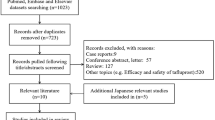Abstract
Dipyridamole is known to inhibit platelet aggregation and to induce vasodilatation. It has been shown that dipyridamole increases blood flow in various tissues in humans as well as in the eyes of animals. We studied the influence of dipyridamole in a prospective open trial in 23 patients with impaired ocular circulation due to different causes, based on experienced clinical judgement, such as anterior ischemic optic neuropathy, vasospastic syndrome, glaucoma, or central retinal vein occlusion. Blood flow velocities in the ophthalmic artery, central retinal artery and vein, one lateral and one medical posterior ciliary artery were measured using a Siemens Quantum 2000 color Doppler device. Blood flow velocities were measured before and under treatment. Dipyridamole increased blood flow velocities significantly in all vessels measured. Therefore, it seems promising to evaluate the effect of dipyridamole over a longer period in patients with impaired ocular blood flow.
Similar content being viewed by others
References
Stafford, A. Potentiaton of adenosine in the adenine nucleotides by dipyridamole. Clin Pharmaeol Exp Ther 1967; 8: 256–60.
Crutchley, DJ, Ryan, US, Ryan, WJ. Effect of aspirin and dipyridamole on the degradation of adenosine diphosphate by cultured cells derived from bovine pulmonary artery. J Clin Invest 1980; 66: 29–35.
Klabunde, RE. Dipyridamole inhibition of adenosine metabolism in human blood. Eur J Pharmacol 1983; 93: 21–6.
Ahlner, J, Anderson, RG, Axelsson, KL, Bunnfors, I, Wallentin, L. Effects of dipyridamole on the glyceryl-trinitrate-induced inhibition of coronary artery muscle tone and platelet aggregation in relation to cyclic nucleotide metabolism. Acta Pharmacol Toxicol 1985; 57: 88–95.
Fitz Gerald, GA. Dipyridamole. N E J Med 1987; 316: 1247–57.
Moncada, S, Korbut, R. Dipyridamole and other phosphodiesterale inhibitors act as antithrombotic agents by potentiation endogenous prostacycline. Lancet 1978; i: 1286–9.
Gresele, P, Zoja, C, Deckmyn, H, Arnout, J, Vermylen, J, Verstraete, M. Dipyridamole inhibits platelet aggregation in whole blood. Thromb Haemost 1983; 50: 852–6.
Alonso, S, O'Brian, GS. Enhancement of the coronary vasodilatator action of adenosine tri-phosphate by dipyridamole. Circ Research 1967; 20: 403–8.
Winbury, MM, Howe, BB, Weiss, HR. Effect of nitroglycerin and dipyridamole on epicardial and endocardial oxygen tension further evidence for redistribution of myocardial blood flow. J Pharmacol Exp Ther 1971; 176: 184–99.
Gasser, P, Flammer, J. Influence of vasospasm on visual function. Doc Ophthalmol 1987; 224: 389–92.
Flammer, J, Guthauser, U, Mahler, M. Do ocular vasospasm help to cause low-tension glaucoma? Doc Ophthalm Proc Series 1987; 49: 397–9.
Flammer, J, Guthauser, U. Behandlung chorioidaler Vasospasmen mit Kalziumantagonisten. Klin Mbl Augenheilkd 1987; 190: 299–300.
Flammer, J, Gasser, P, Prünte, Ch, Yao, K. The probable involvement of factors other than intraocular pressure in the pathogenesis of glaucoma. In: Drance, SM, Van Burskirk, EM, Neufeld, AH (eds) ‘Pharmacology of glaucoma’. Williams and Wilkins, Baltimore, pp 273–283, 1992.
Gasser, P, Flammer, J, Mahler, F. The use of calcium antagonists in the treatment of ocular circulation symptoms in the framework of a vasospastic syndrome. Schweiz Med Wochenschr 1988; 118: 201–4.
Kitazawa, J, Shirai, H, Go, FJ. The effect of calcium antagonists on visual field in low-tension glaucoma. Graefes Arch Clin Exp Ophthalmol 1989; 227: 408–12.
Gasser, P, Flammer, J. Short- and long-term effect on nifedipine on the visual field in patients with presumed vasospasm. J Int Med Res 1990; 18: 334–9.
Gaspar, AZ, Flammer, J, Hendrickson, Ph. Influence of nifedipine on the visual fields of patients with optic-nerve-head diseases. Eur J Ophthalmol 1994; 4: 24–8.
Mermoud, A, Faggioni, R, Van Melle, GD. Double-blind study in the treatment of normal-tension glaucoma with naftidrofuryl. Ophthalmologica 1990; 201: 145–51.
Flammer, J. Therapeutic aspects of normal-tension glaucoma. Curr Opin Ophthalmol 1993; 4: 58–64.
Braunagel, SC, Xiao, JG, Chiou, GCY. The potential role of adenosine in regulation of blood flow in the eye. J Ocular Pharmacol 1988; 4: 61–73.
Meyer P, Flammer J, Lüscher Th. Effect of dipyridamole on vascular responses of porcine ciliary arteries. Exp Eye Res (in print).
Moriya, S, Sugiyama, T, Shimizu, K, Hamada, J, Tokuoka, S, Azuma, I. Low-tension glaucoma and endothelin (ET-1). Folia Ophthalmol Jpn 1992; 43: 554–9.
Kaiser, HJ, Flammer, J, Wenk, M, Lüscher, T. Endothelin-1 plasma levels in normal-tension glaucoma: abnormal response to postural change. Graefe's Arch Clin Exp Ophthalmol 1995; 233: 484–8.
Pourcelot, L. Applications cliniques de l'examen Doppler transcutane. INSERM 1974; 34: 213–40.
Author information
Authors and Affiliations
Rights and permissions
About this article
Cite this article
Kaiser, H.J., Stümpfig, D. & Flammer, J. Short-term effect of dipyridamole on blood flow velocities in the extraocular vessels. Int Ophthalmol 19, 355–358 (1995). https://doi.org/10.1007/BF00130854
Accepted:
Issue Date:
DOI: https://doi.org/10.1007/BF00130854




